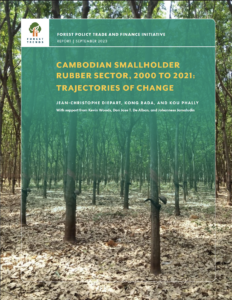Cambodian Smallholder Rubber Sector, 2000 to 2021: Trajectories of Change
By Jean-Christophe Diepart, Kong Rada, and Kou Phally View PublicationIn Cambodia, rubber production plays a strategic role in the country’s agricultural development, influencing land use, employment as well as the overall export-orientation of the country’s agro-industry. While rubber production occurs on large-scale estates (Economic Land Concessions and privatized State-Owned Enterprises), the government has prioritized smallholder rubber production as a key contribution to the National Strategic Development Plan.
The sector remains dominated by large estates but smallholder rubber contribution is significant. According to official figures, as of 2020, 735,000 hectares (ha; 76 percent) of the land area designated for rubber production had been granted as economic land concessions, 66,000 ha (7 percent) as former state-owned enterprises (now privatized), and 161,000 ha (17 percent) as smallholder rubber landholdings. By 2019, there were 32,100 smallholder rubber households cultivating a total area of 161,103 ha of rubber, 74 percent of whom have a rubber landholding smaller than 4 ha. Smallholder rubber households are relatively more effective than large estates in turning land into actual rubber plantation. As of 2020, smallholder rubber landholdings represented 36 percent of the total rubber area actually planted in the country.
The entire sector suffered a downturn after rubber prices peaked in 2011. Yet no study in Cambodia has examined how this downturn of the last decade has affected the dynamic of smallholder rubber as it relates to the land-use/land cover dynamics, smallholder livelihoods, and the value chain to which smallholders contribute. The report aims to fill this knowledge gap. It brings together the findings of a field-based research project conducted in 2020 and 2021 in three smallholder rubber hotspots in Cambodia (Kampong Cham/Tbong Khmum, Kratie, and Ratanak Kiri provinces).
We examine three interrelated topics. At the landscape level, we conducted a land cover and land-use change analysis to contextualize rubber in the overall dynamic of land systems of Cambodia over the past two decades and to understand the extent to which rubber price dynamic has acted as a driver of deforestation. At the smallholder farmer level, we examine how the rubber price drop influenced the socio-economic differentiation between smallholder rubber farming systems and impacted their income and livelihood. At the rubber value chain level, we looked at how rubber prices influenced the creation and distribution of value added along the different segments of the commodity chain (e.g., from production to export).

